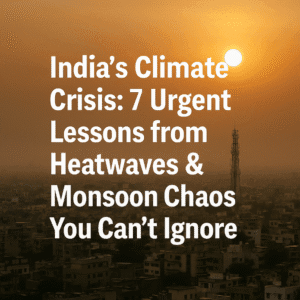India’s Climate Crisis: 7 Urgent Lessons from Heatwaves & Monsoon Chaos You Can’t Ignore
India is grappling with intensifying heatwaves and unpredictable rainfall, highlighting urgent climate challenges. This week, 12 cities recorded above-normal temperatures, with Agartala facing the sharpest rise, while thunderstorms temporarily cooled some areas. The India Meteorological Department (IMD) forecasts an early monsoon onset in Kerala, though rainfall patterns remain volatile. These extreme conditions call for better urban planning, infrastructure, and adaptive systems.
The global context, from Greece’s flood risks to Southern Africa’s heat extremes, underscores the need for proactive climate resilience. India must invest in sustainable infrastructure, modern drainage, and renewable energy to navigate the climate crisis. Lessons from other regions show the importance of flexible, long-term policies and international collaboration.

India’s Climate Crisis: 7 Urgent Lessons from Heatwaves & Monsoon Chaos You Can’t Ignore
As India navigates a complex weather landscape, recent updates reveal a nation grappling with extreme heat, unpredictable rainfall, and the looming monsoon season—all against a backdrop of global climate challenges. Here’s a breakdown of critical developments and their broader implications.
Heatwaves Intensify Across Indian Cities
Twelve Indian cities recorded above-normal maximum temperatures this week, with Agartala experiencing the sharpest spike. This follows a pattern of rising nighttime temperatures, as seen in Patna and Agartala earlier, signaling a worrying trend of prolonged heat stress. While thunderstorms have temporarily cooled some regions, the India Meteorological Department (IMD) warns of persistent heatwave conditions in northwestern, eastern, and central India until mid-May.
Why it matters: Heatwaves strain infrastructure, agriculture, and public health. The interplay between sudden thunderstorms and heat highlights the volatility of regional microclimates, demanding adaptive urban planning and early warning systems.
Monsoon 2025: Early Onset Predictions
The IMD forecasts an early Southwest Monsoon (SWM) onset over Kerala by May 27, four days ahead of schedule. This aligns with predictions of above-normal rainfall, driven by a low-pressure system in the Bay of Bengal. While this system may pull monsoon winds earlier, its limited intensification suggests minimal disruption to the monsoon’s progression.
Key insight: April and May’s frequent thunderstorms, fueled by western disturbances and cyclonic circulations, have cooled land surfaces. However, experts like climatologist Raghu Murtugudde note these storms are unlikely to delay the monsoon, though soil moisture from rains could influence cyclonic activity.
Global Parallels: Greece’s Climate Trap
Greece exemplifies a global “climate trap,” where droughts amplify flood risks. Prolonged dry spells compact soils, reduce vegetation, and clog riverbeds, creating perfect conditions for flash floods. Scientific solutions—like early warning systems, nature-based floodplains, and updated drainage designs—are clear, yet political inertia stalls implementation. The EU recently censured Greece for lagging flood preparedness, underscoring a global challenge: transitioning from reactive disaster response to proactive resilience.
Lesson for India: Greece’s struggles mirror India’s need for upgraded infrastructure and policies that prioritize long-term climate adaptation over short-term fixes.
Southern Africa’s Uncertain Climate Future
Even if global Net Zero emissions are achieved by 2050, Southern Africa faces persistent heat extremes. Climate models show conflicting outcomes—some predict reduced heatwaves, others suggest little change. The region’s sensitivity to rainfall variability complicates projections, as droughts and floods remain intertwined threats.
Takeaway: Uncertainty is no excuse for inaction. Southern Africa’s plight emphasizes the need for flexible policies that prepare for multiple scenarios, from intensified irrigation to urban heat management.
Connecting the Dots
- Localized Adaptation: India’s mix of heatwaves and thunderstorms demands hyper-local weather monitoring and infrastructure tailored to handle both extremes.
- Global Solidarity: From Greece’s floods to Africa’s heat, climate resilience requires international knowledge-sharing and funding.
- Beyond Net Zero: Emission reduction is crucial, but regional climate responses must address legacy impacts already in motion.
The Road Ahead
As India braces for monsoon rains, the dual focus must be on immediate disaster preparedness and long-term climate strategy. Learning from global examples, the nation can champion adaptive policies—modernizing drainage, restoring floodplains, and investing in renewable energy—to turn climate challenges into opportunities for sustainable growth. The clock is ticking, but with collaboration and innovation, resilience is within reach.
You must be logged in to post a comment.